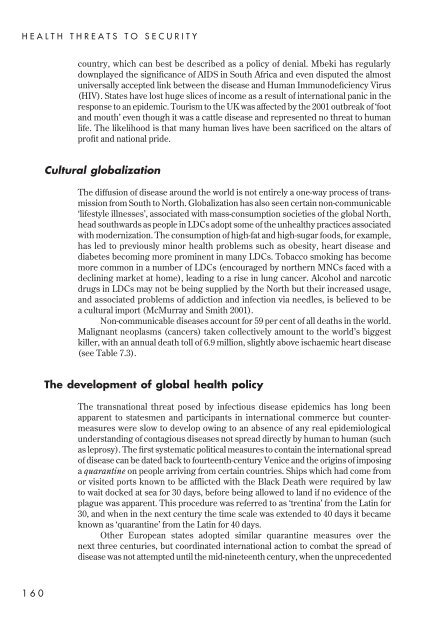Understanding global security - Peter Hough
Understanding global security - Peter Hough
Understanding global security - Peter Hough
You also want an ePaper? Increase the reach of your titles
YUMPU automatically turns print PDFs into web optimized ePapers that Google loves.
HEALTH THREATS TO SECURITY<br />
country, which can best be described as a policy of denial. Mbeki has regularly<br />
downplayed the significance of AIDS in South Africa and even disputed the almost<br />
universally accepted link between the disease and Human Immunodeficiency Virus<br />
(HIV). States have lost huge slices of income as a result of international panic in the<br />
response to an epidemic. Tourism to the UK was affected by the 2001 outbreak of ‘foot<br />
and mouth’ even though it was a cattle disease and represented no threat to human<br />
life. The likelihood is that many human lives have been sacrificed on the altars of<br />
profit and national pride.<br />
Cultural <strong>global</strong>ization<br />
The diffusion of disease around the world is not entirely a one-way process of transmission<br />
from South to North. Globalization has also seen certain non-communicable<br />
‘lifestyle illnesses’, associated with mass-consumption societies of the <strong>global</strong> North,<br />
head southwards as people in LDCs adopt some of the unhealthy practices associated<br />
with modernization. The consumption of high-fat and high-sugar foods, for example,<br />
has led to previously minor health problems such as obesity, heart disease and<br />
diabetes becoming more prominent in many LDCs. Tobacco smoking has become<br />
more common in a number of LDCs (encouraged by northern MNCs faced with a<br />
declining market at home), leading to a rise in lung cancer. Alcohol and narcotic<br />
drugs in LDCs may not be being supplied by the North but their increased usage,<br />
and associated problems of addiction and infection via needles, is believed to be<br />
a cultural import (McMurray and Smith 2001).<br />
Non-communicable diseases account for 59 per cent of all deaths in the world.<br />
Malignant neoplasms (cancers) taken collectively amount to the world’s biggest<br />
killer, with an annual death toll of 6.9 million, slightly above ischaemic heart disease<br />
(see Table 7.3).<br />
The development of <strong>global</strong> health policy<br />
The transnational threat posed by infectious disease epidemics has long been<br />
apparent to statesmen and participants in international commerce but countermeasures<br />
were slow to develop owing to an absence of any real epidemiological<br />
understanding of contagious diseases not spread directly by human to human (such<br />
as leprosy). The first systematic political measures to contain the international spread<br />
of disease can be dated back to fourteenth-century Venice and the origins of imposing<br />
a quarantine on people arriving from certain countries. Ships which had come from<br />
or visited ports known to be afflicted with the Black Death were required by law<br />
to wait docked at sea for 30 days, before being allowed to land if no evidence of the<br />
plague was apparent. This procedure was referred to as ‘trentina’ from the Latin for<br />
30, and when in the next century the time scale was extended to 40 days it became<br />
known as ‘quarantine’ from the Latin for 40 days.<br />
Other European states adopted similar quarantine measures over the<br />
next three centuries, but coordinated international action to combat the spread of<br />
disease was not attempted until the mid-nineteenth century, when the unprecedented<br />
160
















